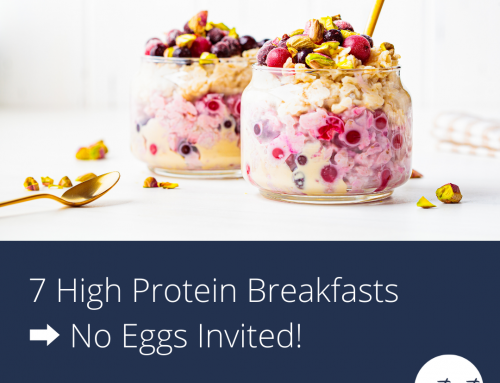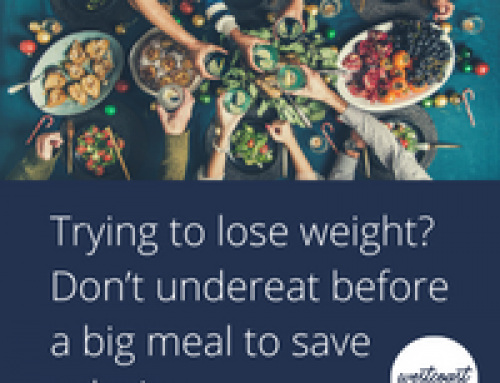There are lots of nutrition myths and mistakes, and today we’re tackling the big one : Focusing your energy on what not to eat. How many times have you been on a diet, or seen a friend try the next new thing? We cut food groups, go sugar/dairy/gluten free, we count every last calorie in the name of trying to feel better in our bodies. This happens to my digestive clients too! So much conflicting information leads you to cut out food after food hoping that it will be the one that was causing all the trouble, until you’re left with a tiny list to choose from.
While learning boundaries around what works for your body is important, our laser focus on what to avoid kicks our butt in two different ways.
Cognitive Restriction
The act of intentional avoidance or restriction taxes our brain’s resources. The negative focus tends to take mental energy, feel restrictive and act a little bit like an elastic band – the longer and harder we restrict, the more we stretch the band until it breaks or snaps back – this is where you fall face first back in to old habits because you’re SO tired of not eating anything you love.
Human brains really love positive focus and reinforcement. So even though we’re still making adjustments that may limit certain foods or nutrients, by turning our focus to what to include more of, we harness our ability to keep going longer and feel happier about it. This leads to sustainable change instead of the diet roller coaster.
Missing Key Nutrients Affects Your Body’s Function and Health
Longer term restriction for any reason (even a good one like Irritable bowel syndrome or a health condition) generally limits important vitamins, minerals, antioxidants and phytonutrients that are needed to keep your metabolic health (including your natural calorie burn), gut health, immune health and energy working properly. When starved of resources our body focuses on survival mechanisms. Repair slows, hormones get out of whack, energy drops to help conserve, and we burn less calories each day. Not to mention we’re no longer supporting the anti-aging, anti-inflammatory and repair systems needed to protect our long term health. My gut health clients are often in this catch 22 where we can’t repair because they’re eating so little, and they’re afraid to eat more because of their gut issues. It’s hard to break the cycle sometimes!
In order to shift the focus both to making healthy eating positive and easier on your brain, as well as nourishing your physical body, start by choosing one or two of my top nutrients and foods to focus on below. Once you’ve nailed those for a few weeks, build another one into your planning.
Focus On Including More Of These
Variety! For gut health, fat loss and energy, getting a variety of foods and colours helps you make sure you cover key vitamins, minerals and anti-inflammatory phytonutrients (many are conveniently colour coded). More on why colour is important here.
Protein! Both enough at EVERY meal, and over the course of the day. You know that saying that we’re all eating too much protein? I almost never see it in my practice. If you’re using appropriate protein recommendations for activity, age and goals (like weight loss, performance, or gut repair) you’re likely not getting enough protein. Protein protects muscle mass, lowers hunger hormones and is the building block of all of our signaling molecules, immune function, gut cells and more.
Good old fibre. The research on fibre is consistent and positive. Fibre supports gut health both through regulating motility and breeding healthy gut bacteria. It provides fullness and reduces inflammation. It seems to help regulate weight (likely through normalizing blood sugar and insulin, but we don’t fully understand this yet) as well. Need ideas on getting more, find them here!
Okay, now let’s dive into some specific groups that will really power up your health goals, energy and nourish that physical body from the inside out.
Berries
Another myth? Exotic foods = better for you. You don’t need anything exotic to power up your nutrition and better support your goals. Berries of all kinds, including our delicious local ones, are a powerhouse of gut healthy fibre, skin, immune and metabolic health antioxidant Vitamin C, and anti-aging (on a cellular level) compounds like Resveratrol. Blueberries, raspberries, strawberries, and blackberries are all fantastic choices.
Quick Fixes:
- Add to yogurt, cereal, or oatmeal
- Toss a few on a rice cake with peanut butter to sweeten it up
- Use to garnish a salad
- Add 1 cup to a smoothie
- Enjoy as a tasty snack all on their own!
Dark Leafy Greens
Do you all get tired of hearing me wax on about how great greens are? I hope not because dark leafy greens will forever be my nutrition BFF. Packed full of fibre, Magnesium, Vitamins A and C (both antioxidants) K (for healthy bones), and key anti-inflammatory nutrients like Lutein and Zeaxanthin (awesome for many things but particularly helping our eyes repair from the daily damage from the sun). I aim to get at least 2 big handfuls of these daily, and it’s not that hard to do!
Quick Fixes:
- Stir wiltable greens like spinach or arugula in to soups, leftovers, curries and stews
- Have a big lunch salad
- Toss 1 -2 handfuls of spinach or kale in to a smoothie
- Pack some in to a sandwich or wrap
- Mix in to scrambled eggs, egg bites or frittata for a breakfast boost
- Use swiss chard or collard leaves to make a “wrap” for tuna salad
Cruciferous Veggies
Not the trendiest of foods, but this group packs a powerful punch. The cruciferous family includes cabbage, broccoli, cauliflower, kale, Brussel sprouts, arugula, bok choy, collard greens, and more. This family not only provides the usual veggie boost of Vitamin C and fibre, but are sulfur rich (sulfur is important for repairing DNA so keeps cells healthier as you age). They also have some of the most potent cell repair and anti-aging nutrients around including glucosinolates which support our anti-inflammatory pathways (important for fat loss, gut health and more), help protect and repair cells from DNA damage (which may mitigate risk for certain cancers) and also have a role to play in regulating hormone health to keep your body working the way it should. Prioritizing these guys in your weekly meal plan will go a long way to improving your health and helping your body function more effectively so you can reach your goals.
Quick Fixes:
- Cole slaw (I buy pre-shredded for convenience)
- Arugula on top of pizza, or as a base for a beautiful salad (a few berries from above helps offset the natural bitterness)
- Sauteed until crispy kale beside my morning eggs
- Kale chips
- Bok Choy steamed and drizzled with something delicious, or thrown on the grill!
- Roasted or grilled broccoli and cauliflower (they also come up crunchy and delicious in the air fryer if you have one)
- Collard green “wraps”
**Gut issues? You may find this group worsens symptoms because they are fermentable (your gut bacteria use them for fuel and create gas). If you have IBS or significant bloating you might want to avoid these for now, but make sure you’re working with someone to heal the gut so you can reintroduce this superstar group**
I hope this inspires you to shift your focus to what you SHOULD include – both for the health benefits, and the sustainability it will lend to your eating habits. Next week’s email (and over on Instagram) I’ll add tasty recipes you can add to your meal planning repertoire to make getting these key nutrients (and keeping your focus on what to eat, instead of what not to) easy.
Need some help getting your meals for the week balanced and prepared? If you’d like to receive our free Meal Planning Getting Started Guide AND get in on our weekly emails about all things nutrition so you can get clarity and confidence on what you’re eating, join us here!







